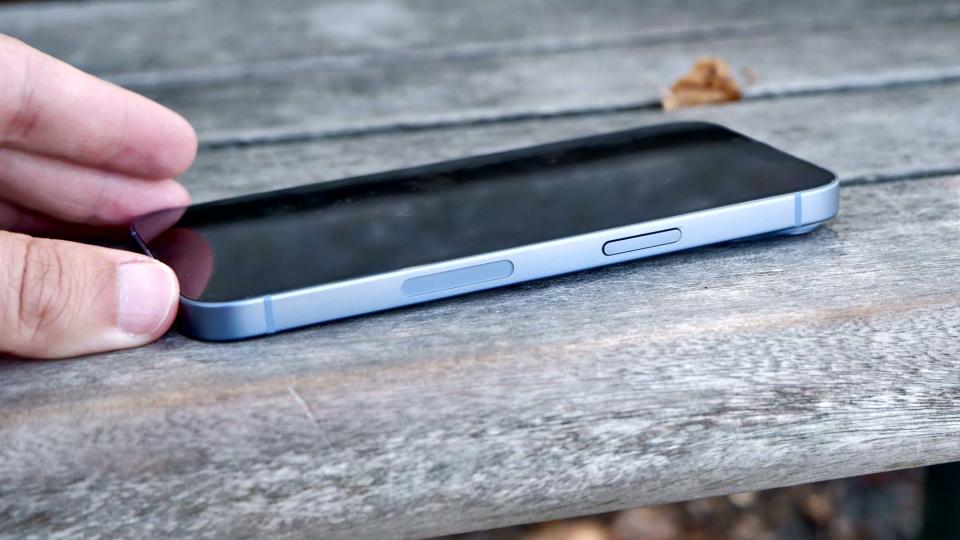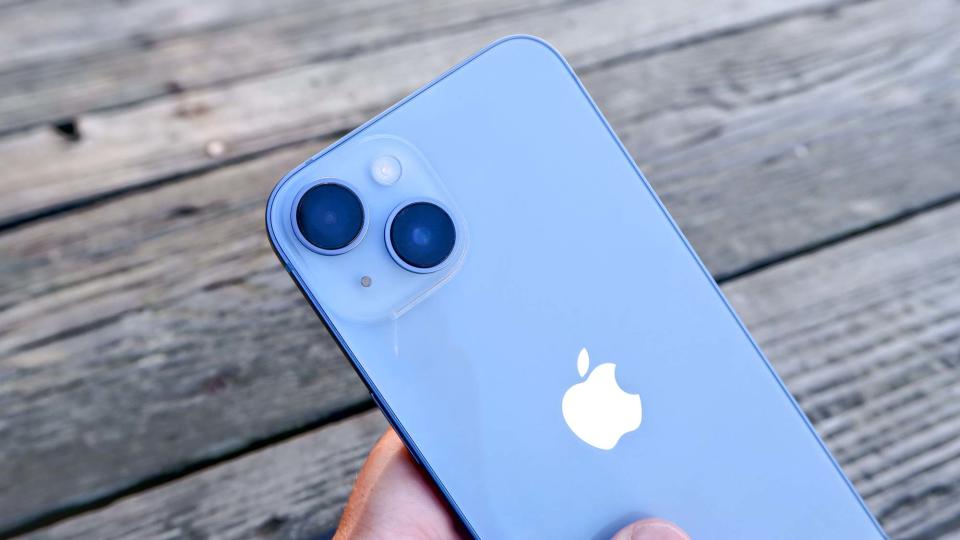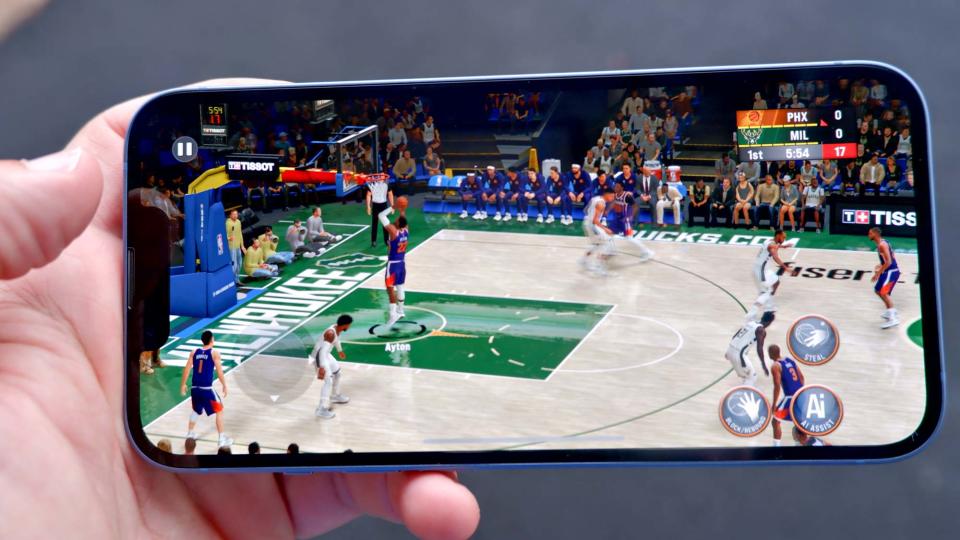Apple iPhone 14 review: Everything you need to know
When you buy through links on our articles, Future and its syndication partners may earn a commission.

Whether you already own one, or are considering upgrading to an older, cheaper iPhone, the iPhone 14 is a strong pick even a year and a half after it first launched.
Some may prefer the bigger iPhone 14 Plus if you want a larger screen and longer battery life. And the iPhone 14 Pro or iPhone 14 Pro Max, plus the latest iPhone 15 series, offer more exciting features like an always-on display, Dynamic Island, 120Hz refresh rate and telephoto zoom.
But the iPhone 14 still features welcome updates like a revised design and improved display, camera and performance. My iPhone 14 review breaks down all the pros and cons so you can decide if this is the right handset for your needs.
Be sure to check out our iPhone 14 vs Galaxy S23 face-off and iPhone 14 vs Pixel 7 comparison to see how the iPhone 14 stacks up to the competition.
More iPhone 14 reviews
iPhone 14 specs
iPhone 14 review: Release date and price
Apple launched the iPhone 14 in September 2022 with a starting price of $799 / £849 / AU$1,399 for the base 128GB model. But now it's available for $699 / £749 / AU$1,299 as a legacy model from Apple's own store, though other retailers may discount it even further.
Be sure to check out our iPhone 14 deals page to make sure you get the lowest price on the new iPhone.
iPhone 14 review: Design and colors
The iPhone 14 design is not what I’d call fresh. It’s basically a carbon copy of the iPhone 13, complete with the notch.

Don’t get me wrong, the aluminum and glass body is solid and fairly attractive — and you get the same tough (removable) Ceramic Shield front and tough glass back, along with IP68 water resistance. But you’ll probably be jealous when you see the iPhone 14 Pro’s Dynamic Island, which replaces the notch with a smaller and interactive cutout for alerts and live activities.

The iPhone 14 colors are Midnight, Starlight, Blue, Purple, Red and Yellow. We tested the paler blue model, which is an attractive cornflower blue shade. Apple announced the iPhone 14 in yellow on March 7.

The iPhone 14 remains compact and fairly light, weighing 6.07 ounces and measuring 5.78 x 2.82 x 0.31 inches. That’s actually a bit lighter than the iPhone 13’s 6.17 ounces, although that model was a slightly thinner 0.30 inches.

In a somewhat controversial move, Apple removed the SIM Card slot from the iPhone 14, relying on eSIMs only. Fortunately, it’s easy to add a line of service in the Settings app, and you can have up to eight 8 SIMs on your phone with two active at any given time (say one for personal and one for business). There are some smaller and international carriers that don’t yet support eSIM, but the technology is gaining traction.
iPhone 14 review: Display
The iPhone 14’s 6.1-inch Super Retina XDR display remains one of the best screens in thi price range in terms of quality, even though there are no upgrades over last year. The biggest missing feature is a 120Hz refresh rate, which the Galaxy S22 offers, so you don’t get the same super smooth scrolling or animation in supported games.

Nevertheless, I enjoyed watching the colorful trailer for Cobra Kai season 5 on the iPhone 14’s panel, as it delivered vibrant colors and wide viewing angles. Viewing photos on the iPhone 14 is also a pleasure, as I could make out droplets of water on a flower petal.

In our lab tests, the iPhone 14 registered 117.4% of the sRGB color gamut and 83.1% of the more demanding DCI-P3 color space. The Galaxy S22 reached 110% and 77.9% on the same tests in Natural mode but a higher 210.4/149.1% in Vivid mode.
The iPhone 14 Pro’s Delta-E accuracy score was a great 0.25 (where 0 is perfect), but the Galaxy S22 scored even better at 0.22.
iPhone 14 review: Cameras
The iPhone 14’s main camera doesn’t get the bump to 48MP that the iPhone 14 Pro series does, but it does feature enhanced cameras in its own way. The main 12MP wide camera has a larger sensor than the one in the iPhone 13, with 1.9 micrometer pixels and a faster f/1.7 aperture. As a result, you should expect better action shots and low-light performance.

The iPhone 14 also packs an ultrawide camera that’s rated to capture 4x more of a scene and deliver 2x better low-light performance. And the TrueDepth camera offers autofocus for the first time along with a faster f/1.9 aperture. To help capture brighter images across the board, there’s a new computational photography feature called Photonic Engine.
Check out the photos below, and see our iPhone 14 vs iPhone 13 camera shootout for more comparisons.
In this first comparison shot with the Galaxy S22 featuring dipladenia flowers, the iPhone 14 shows how superior its cameras can be. On the iPhone, you can make out not just more details in the petals but more water droplets.
The iPhone 14 also has the edge versus the Pixel 6 in this shot of Halloween decorations. The colors are punchier on the iPhone when you look at the sunflowers and gnomes, though the Pixel does a better job exposing the decorations in the shadowy background.
Turning to the ultrawide camera, the iPhone 14 edges out the Pixel 6 with a slightly brighter image with more contrast as you look at the tree in the water. And it fits in more of the scene, though both images are excellent.
With Night mode engaged, the iPhone 14 captures a brighter image than the Pixel 6 of this fire pit area, even if the iPhone’s image looks a bit more artificially lit. Still, I like how sharp the paving stones look in Google’s shot, and how crisp the lights are.
The iPhone 14 fell behind the Galaxy S22 in this Night mode photo of Star Wars figurines indoors in near darkness. The colors are more realistic in the Samsung pic, and the Star Wars text is sharper.
The front camera on the iPhone 14 performed well in this selfie, offering a brighter shot overall with more detail in my face and hair. And the surrounding plants look more vibrant, too. I do like that the Pixel 6 gives you more room for a group selfie though.
One bummer is that the iPhone 14 maxes out at just 5x digital zoom, which pales in comparison to the Galaxy S22's 3x optical zoom and 30x digital zoom. In this 5x zoom photo of the Chrysler building, the iPhone 14 produces a brighter image with more detail in the building and the colors are closer to what I saw in person. But the Galaxy S22's shot paints a bluer sky.
However, as you can see here the Galaxy S22 is capable of pushing in way further with its Space Zoom feature. You can make out the top three sections of the building way up close.
iPhone 14 review: Video
The iPhone 14’s big video upgrade is Action mode, which is designed to deliver smooth and steady video when you’re in motion. To turn it on, you just toggle a button in the camera app, and overall it works quite well.
When walking around my patio in a circle, the iPhone 14’s footage looked a bit smoother than what the Galaxy S22 captured; when watching on an HDR display, the iPhone’s clip was more vibrant as well.
iPhone 14 review: Performance
The iPhone 14’s chip is new and old at the same time. It’s the A15 Bionic from last year’s iPhone 13 Pro, so you get a slight step up in graphics performance with its 5-core GPU.
In my testing, I was impressed with the console-like visuals offered by Oceanhorn 2 (a Zelda-like adventure title). I marveled at the water near a dock and the undulating light reflecting off the ripples.

NBA 2K also delivered dazzling graphics, including a realistic looking Giannis Antetokounmpo looking downtrodden after I failed to score. Another plus, the iPhone 14 didn’t get too warm while playing for 30 minutes, and this is likely thanks to a new internal design that’s optimized for dissipating heat.
On Geekbench, which measures overall performance, the iPhone 14 scored 1,727 in single core and 4,553 in multicore. That’s just slightly higher than the iPhone 13 (1,668/4,436) but well above the Galaxy S22 (1,204/3,348).
We saw a bigger boost in graphics performance, where the iPhone 14 turned in a score of 11,531 and 69 frames per second on 3DMark Wild Life Unlimited. The iPhone 13 mustered 9.331 and 51 fps. The Galaxy S22 was behind once again at 9,976/59 fps.
We didn’t see an improvement in our video editing test, which involves transcoding a 4K video clip to 1080p in the Adobe Premiere Rush app. It took the iPhone 14 28 seconds compared to a slightly faster 25.9 seconds for the iPhone 13. Still, the Galaxy S22 needed 47 seconds.
If you're interested in our full results, and how they compare to other iPhones, take a look at our iPhone 14 benchmarks guide or the iPhone 14 vs iPhone 13 benchmarks that compare the two phones.
iPhone 14 review: Battery life and charging
We also put the iPhone 14 through the Tom's Guide Battery Test, which involves continuous 5G web surfing at 150 nits of screen brightness. The iPhone 14 lasted 9 hours and 28 minutes. While that's not enough to make our best phone battery life list, this runtime does beat the Galaxy S22 (8:02) and Google Pixel 7 (7:14).
The iPhone 14 sticks with 20W charging, so our charge time results are not surprising. The phone reached 54% in 30 minutes, which is a bit better than Apple’s 50% claim. And we got to 27% in 15 minutes.

In contrast, the OnePlus 10T can reach 84% charge in 15 minutes and 100% charge in just 20 minutes via its 150W charging system (though charge speeds are slower in the U.S.). And the Galaxy S22 got to 60% in 30 minutes with its 25W charger.
For more check out our iPhone 14 battery life tested roundup to see how long all four new iPhones last on a charge.
iPhone 14 review: Emergency SOS via satellite and crash detection
Apple will launched two key safety features for the iPhone 14. The first is Emergency SOS via satellite, which combines new antennas and software to connect to satellites when you can’t get a cellular or Wi-Fi signal. You’ll then get help from emergency services to your location, or can send your location to a contact. This is available for free for three years after the phone's activated, meaning that you'll at least make it to 2025 before needing to pay for this service.
During a demo, the iPhone 14 locked onto a satellite quickly, and the phone walks you through a series of questions so Apple can tell dispatchers everything they know about your condition and exact location.
The second safety feature is Crash Detection, which leverages the iPhone 14’s improved accelerometer and gyroscope to detect whether you’re in a car crash. From there, it can automatically dial emergency services, as well as notify your emergency contacts you designate.
In one iPhone 14 Crash Detection test by a YouTuber, the feature worked well during simulated crashes using a remote-controlled vehicle. Both times, the iPhone began its countdown to automatically call emergency services before being canceled.
iPhone 14 review: iOS 16
The iPhone 14 runs iOS 16 by default, and there’s a lot to like in this new software update. You can customize the lock screen with widgets, photos and more. Other highlights include the ability to unsend texts and edit them, a replacement for passwords called Passkeys, a new Fitness app and (finally) the return of the battery percentage indicator.

As of fall 2024, the iPhone 14 series is able to update to iOS 17, and iOS 18 once it's out of beta. Unfortunately, no iPhone 14 models are capable of using Apple Intelligence once it's available.
iPhone 14 review: Verdict
The iPhone 14 is the best iPhone for most people, but despite that, it’s not that exciting. The iPhone 14 Pro and iPhone 14 Pro Max get the biggest upgrades this year, including always-on displays, a clever replacement for the notch and a 48MP main camera.

Still, there’s a lot to like for $799. The iPhone 14 delivers fantastic-looking photos and video; the display is stellar; and you get performance that still beats the best Android phones — except for the new Galaxy S23. (Be sure to check out our Galaxy S23 vs. iPhone 14 face-off for more details.) Action mode is another plus if you’re looking for super smooth video. Plus Apple may be offering easier access to repairs for this generation, giving the iPhone 14 a surprise advantage over the iPhone 13.
If you’re not wedded to iOS, Samsung’s Galaxy S22 is better in some ways, as it offers both a telephoto zoom lens and 120Hz display — two features Apple reserves for its Pro models. But the S22’s cameras and performance aren’t quite as good as the iPhone 14. You can check out our detailed comparison between the phones in our iPhone 14 vs Samsung Galaxy S22 face-off. (You can also check out how the Samsung Galaxy S23 vs iPhone 14 battle is shaping up based on rumors on the S23).
If you want longer battery life and a bigger display, you might want to wait for the $899 iPhone 14 Plus, but overall the iPhone 14 is a great — yet safe — choice.
Next: Here's a detailed guide on how to activate eSIM on your iPhone 14. If you have just bought an iPhone 14, you can check out our guide to the best iPhone 14 cases. We also did a Google Pixel 7 vs. iPhone 14 camera shootout to see which phone wins?
